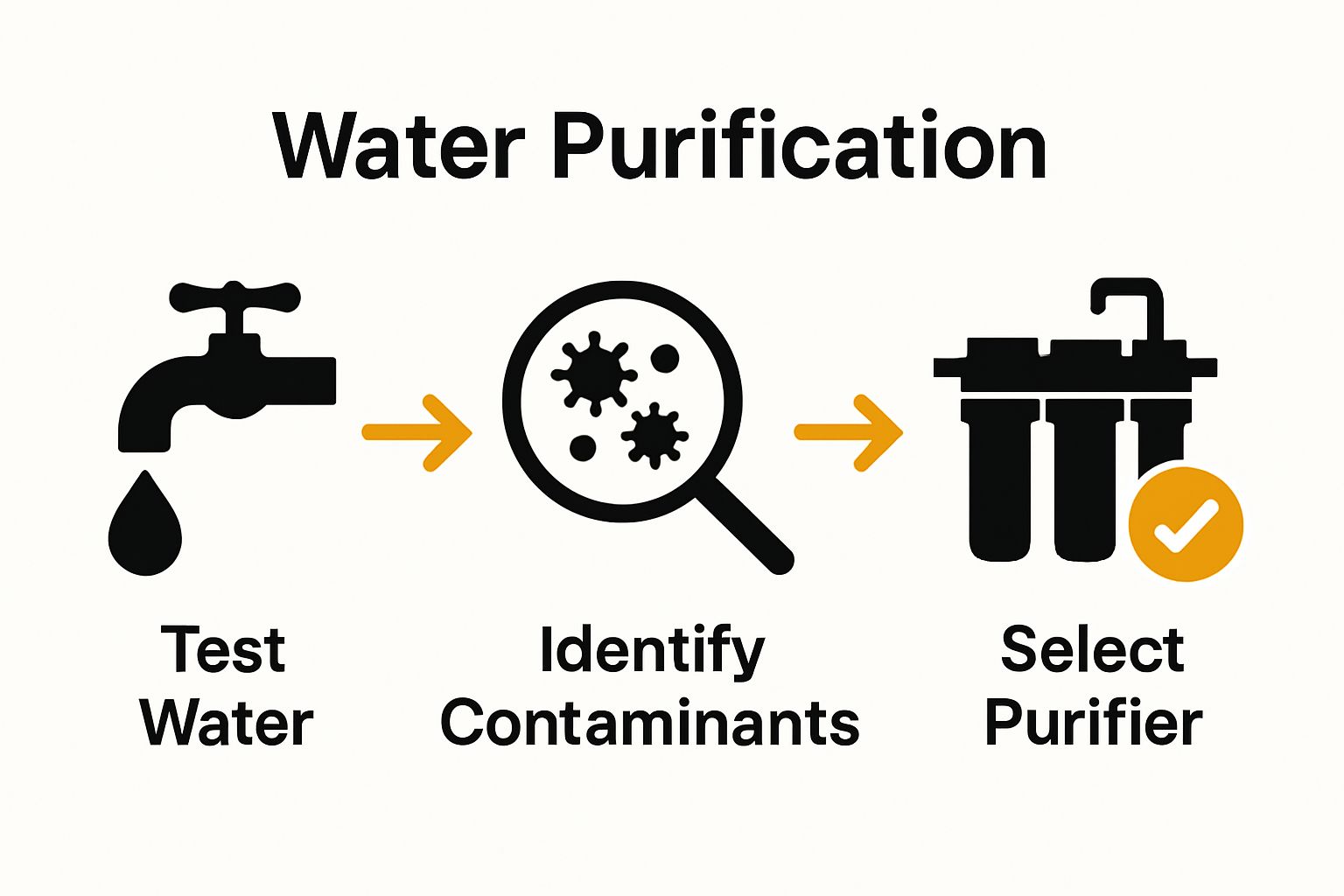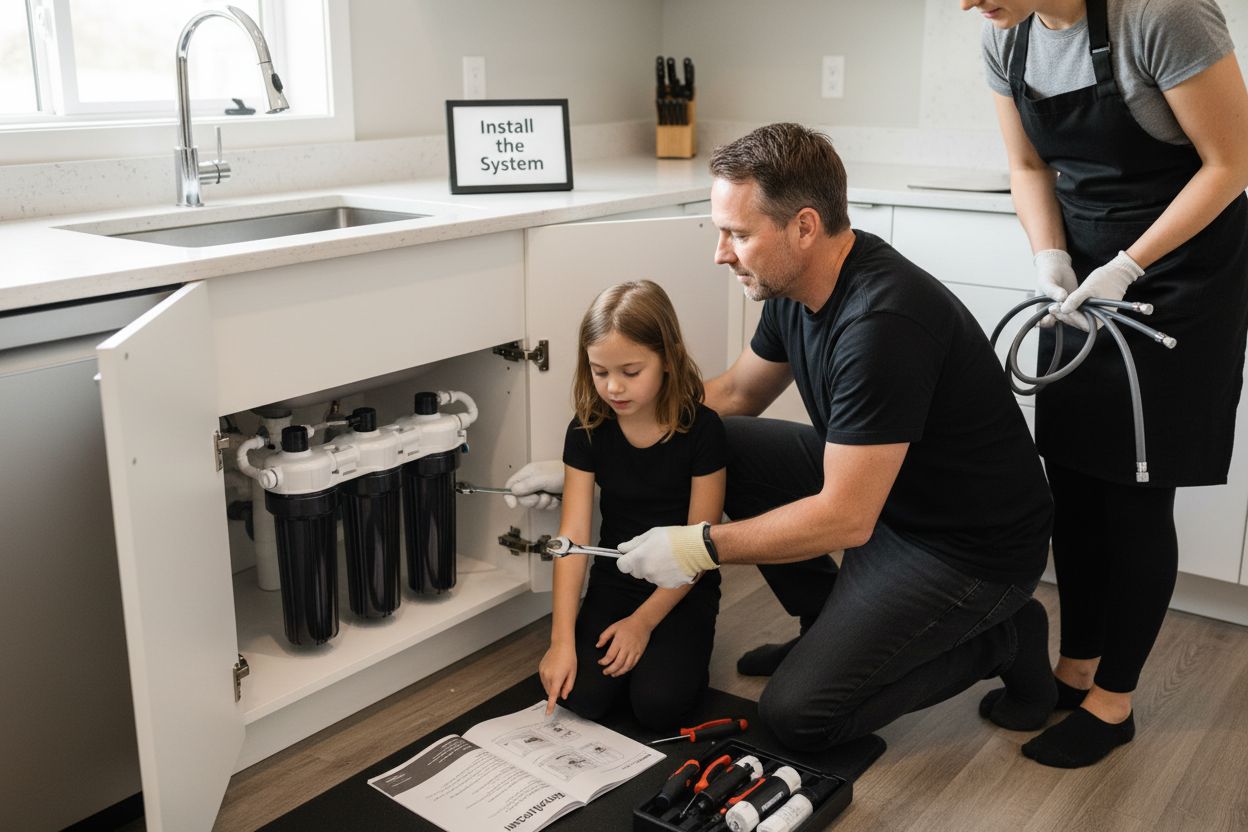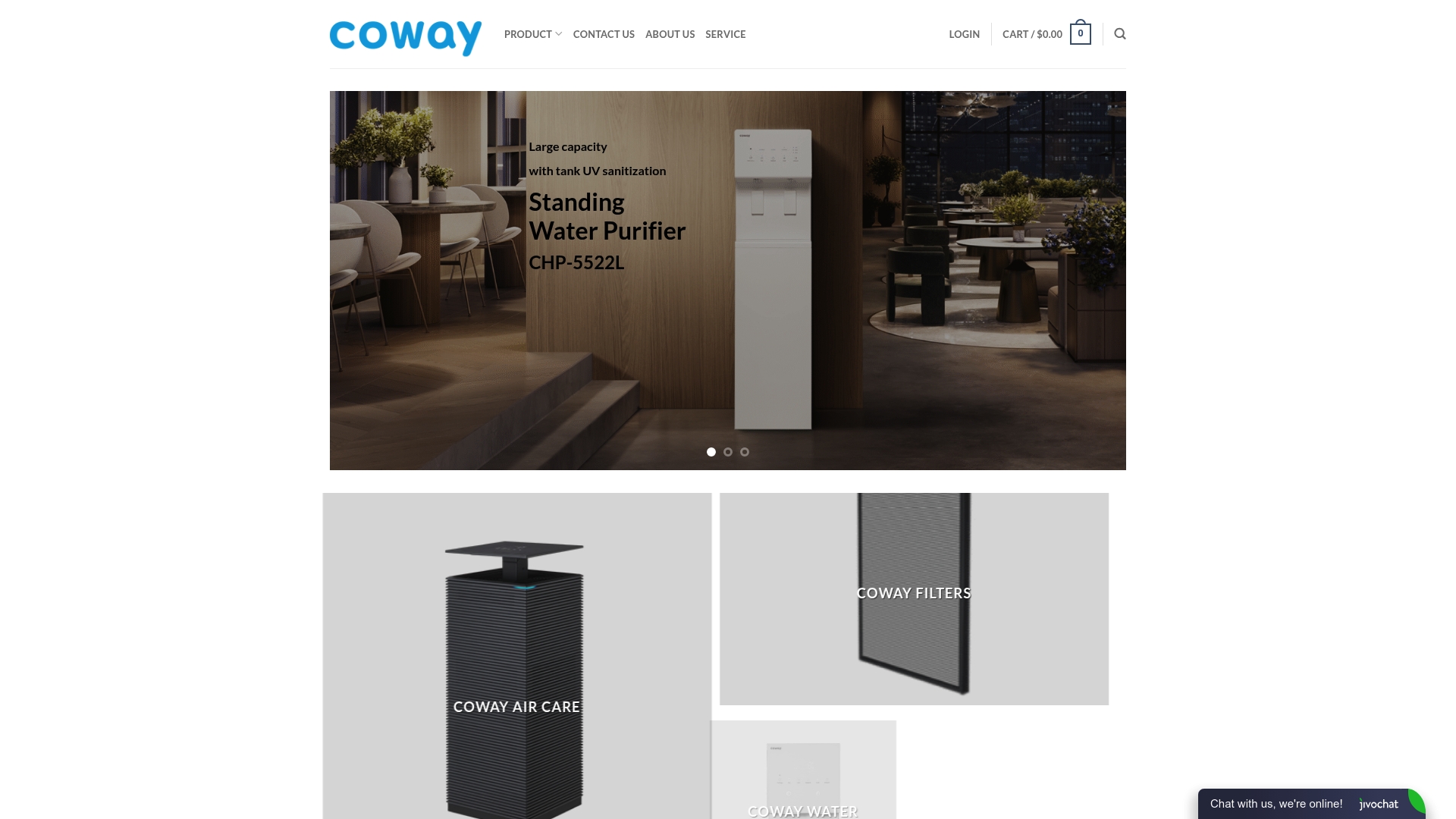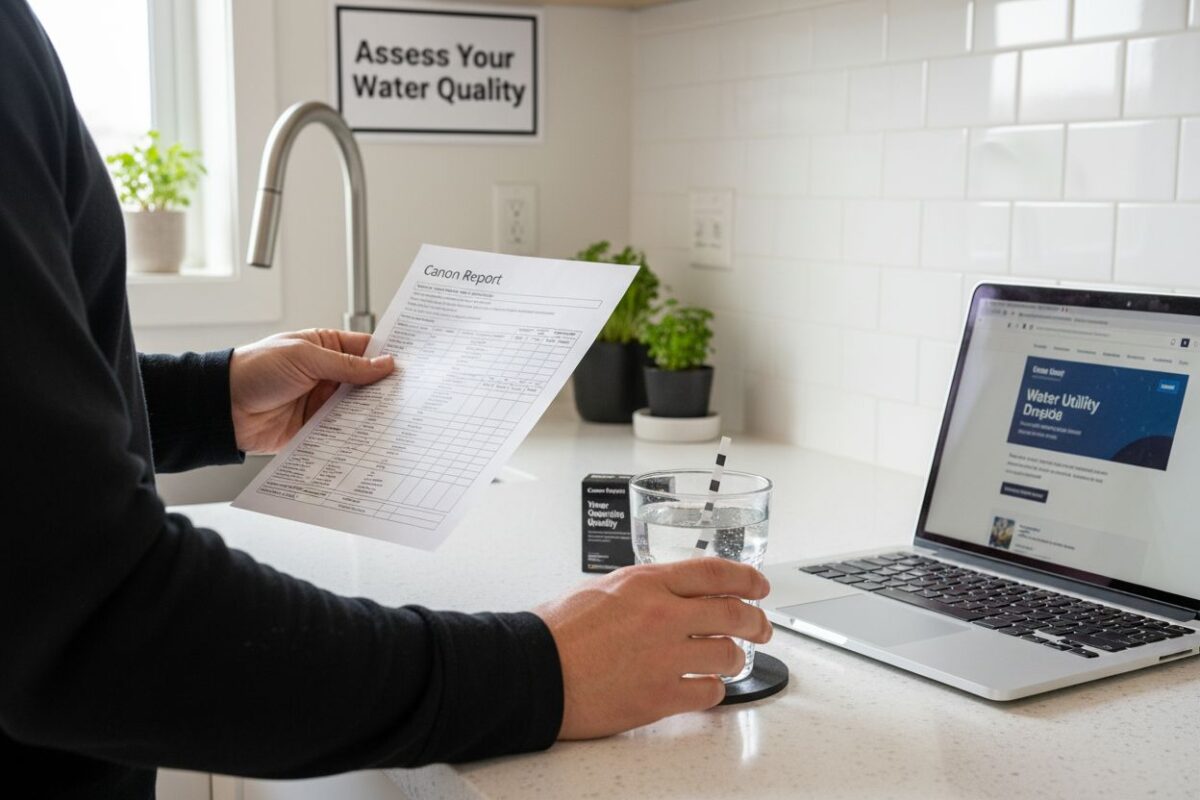Uncategorized
How to Choose Water Purifier: A Step-by-Step Guide
Picking the right water purifier sounds simple, but the truth is your tap could be hiding more than you realize. Water quality swings wildly from one home to the next and what works for your neighbor might do nothing for you. The surprise? The most expensive system on the shelf can leave you exposed if it does not match what is actually in your water.
Table of Contents
- Step 1: Assess Your Water Quality Needs
- Step 2: Research Different Water Purification Technologies
- Step 3: Compare Features And Benefits Of Options
- Step 4: Evaluate Costs And Maintenance Requirements
- Step 5: Read Reviews And Seek Recommendations
- Step 6: Make Your Purchase And Install The System
Quick Summary
| Key Point | Explanation |
|---|---|
| 1. Assess your water quality needs | Understand specific contaminants in your water supply to select the right purification system. |
| 2. Research various purification technologies | Each technology targets different contaminants; choose one that meets your specific water issues. |
| 3. Evaluate costs and maintenance | Consider long-term expenses beyond initial price, including filter replacements and energy consumption. |
| 4. Compare features and benefits | Create a comparison matrix for filtration efficiency, capacity, and additional features to informed decision-making. |
| 5. Read reviews and seek recommendations | Leverage consumer experiences and expert advice to identify reliable water purification systems tailored to your needs. |
Step 1: Assess Your Water Quality Needs
Choosing the right water purifier begins with understanding your specific water quality challenges. Water quality varies significantly across different locations, making a personalized assessment crucial for selecting an effective filtration system. The first step involves investigating what contaminants might be present in your water supply and understanding their potential health implications.
To start your assessment, obtain a comprehensive water quality report from your local water utility. Our guide on safe drinking water provides additional insights into reading these reports. Most municipalities are required to provide annual Consumer Confidence Reports that detail water testing results, revealing potential contaminants such as:
- Heavy metals like lead and mercury
- Bacterial and viral microorganisms
- Chemical pollutants including chlorine and fluoride
- Sediment and mineral content
If your local utility report seems insufficient, consider purchasing a home water testing kit. These affordable kits can detect a wide range of potential contaminants and provide a more granular understanding of your specific water composition. Professional laboratory testing offers the most accurate results, though it comes at a higher cost.
Beyond testing, consider your household’s unique water usage patterns. A family with young children or individuals with compromised immune systems might require more robust filtration compared to a single adult household. Different water sources demand different purification strategies water from wells, municipal systems, and rural areas each present distinct contamination risks.
Your assessment should also factor in visual and sensory indicators. Unusual taste, color, or odor in your water can signal underlying quality issues. Rust colored water might indicate high iron content, while a chlorine smell could suggest excessive treatment chemicals. These observations, combined with professional testing, will help you pinpoint the exact purification technology needed for your home.

Step 2: Research Different Water Purification Technologies
After understanding your water quality needs, the next critical step is exploring the various water purification technologies available in the market. Water purification is not a one size fits all solution, and different technologies address specific contamination challenges more effectively than others. Learn about the latest water filtration methods to make an informed decision.
Reverse osmosis represents one of the most comprehensive purification technologies. This method forces water through an ultra fine membrane, removing up to 99% of dissolved solids, heavy metals, and microscopic contaminants. Households with extremely hard water or significant chemical contamination often benefit most from reverse osmosis systems. However, these systems can be more expensive and tend to waste more water during the filtration process.
Ultraviolet purification offers another powerful approach, utilizing specific light wavelengths to neutralize bacteria, viruses, and other microorganisms. This technology is particularly effective against biological contaminants but does not remove chemical pollutants or improve water taste. Many modern water purifiers combine UV technology with additional filtration methods to provide more comprehensive protection.
Activated carbon filtration presents a versatile and cost effective solution for many households. These filters excel at removing chlorine, sediment, volatile organic compounds, and improving water taste and odor. Compact and relatively inexpensive, activated carbon systems work well for municipal water supplies with mild to moderate contamination levels.
Multistage filtration systems have gained popularity for their comprehensive approach. These advanced purifiers combine multiple technologies like sediment filters, activated carbon, reverse osmosis, and UV treatment to provide thorough water purification. While more expensive upfront, they offer the most robust protection against a wide range of potential contaminants.
As you research, consider factors beyond filtration effectiveness. Maintenance requirements, filter replacement costs, water waste rates, and energy consumption all play crucial roles in selecting the right water purification technology for your home.
Here is a comparative table summarizing the main water purification technologies, their strengths, and limitations to help you quickly assess which best fits your water quality needs.
| Technology | What It Removes | Strengths | Limitations |
|---|---|---|---|
| Reverse Osmosis (RO) | Dissolved solids, heavy metals, chemicals | Comprehensive filtration, effective for hard/contaminated water | Higher cost, water wastage, may need tank |
| Ultraviolet (UV) | Bacteria, viruses, microorganisms | Effective against biological contaminants | Does not remove chemicals or improve taste |
| Activated Carbon | Chlorine, sediment, VOCs, improves taste/odor | Affordable, improves taste/odor, low-maintenance | Limited removal of heavy metals/microbes |
| Multistage Filtration | Broad spectrum (chemicals, germs, sediments) | Most comprehensive, combines multiple methods | Higher upfront cost |
Step 3: Compare Features and Benefits of Options
Comparing water purifier options requires a strategic approach that goes beyond simple price comparisons. The most expensive system is not always the best solution for every household. Explore sustainable water purification methods to understand the nuanced differences between various technologies.
When evaluating water purifiers, create a comprehensive comparison matrix that considers multiple critical factors. Filtration efficiency stands as the primary consideration, measuring the system’s ability to remove specific contaminants identified in your earlier water quality assessment. Look for purifiers with certifications from recognized testing organizations that validate their performance claims.
Capacity and flow rate represent another crucial comparison point. Larger families require systems that can produce more filtered water quickly, while smaller households might prioritize compact designs. Calculate your household’s daily water consumption and match it against the purifier’s output capabilities. Some advanced systems offer real time indicators showing filter life and water production rates, providing additional convenience.
Maintenance requirements and long term costs demand careful evaluation. Seemingly affordable systems can become expensive over time due to frequent filter replacements or high energy consumption. Compare the following financial aspects:
- Initial purchase price
- Annual filter replacement costs
- Energy efficiency ratings
- Warranty coverage
- Installation expenses
Additional features can significantly enhance user experience. Modern water purifiers offer smart technology integrations like smartphone connectivity, automatic filter replacement notifications, and precise contaminant tracking. Water remineralization capabilities represent another advanced feature that can improve water taste and nutritional value by reintroducing beneficial minerals after filtration.
Consider your specific lifestyle and space constraints when comparing options. Under sink systems provide excellent filtration but require permanent installation, while countertop models offer flexibility for renters or those with limited kitchen space. Aesthetic design matters too select a purifier that complements your home’s interior and meets your functional requirements. Take time to read user reviews, request product demonstrations, and verify manufacturer support before making your final decision.
Step 4: Evaluate Costs and Maintenance Requirements
Beyond initial purchase price, water purifiers involve complex long term financial considerations that can significantly impact your household budget. Total cost of ownership extends far beyond the sticker price, requiring a comprehensive financial assessment. Learn more about sustainable water treatment strategies to make an informed decision.
According to University of Georgia Extension researchers, systematic maintenance plays a crucial role in water purifier performance and longevity. Filter replacement represents the most consistent ongoing expense. Different purification technologies demand varying maintenance schedules some require monthly replacements, while others can last six months to a year. Calculate anticipated annual filter costs by multiplying the replacement filter price with expected frequency of changes.
Energy consumption presents another critical financial consideration. Advanced reverse osmosis and UV purification systems might consume more electricity compared to simpler activated carbon filters. Look for energy efficiency ratings and estimated annual operating costs when comparing systems. Some modern purifiers feature smart technology that helps track filter life, water consumption, and potential maintenance needs, potentially reducing long term expenses.
Beyond direct costs, consider these financial factors:
- Warranty coverage duration
- Cost of professional installation
- Potential repair expenses
- Replacement part availability
- System lifespan expectations
Warranties can significantly offset potential maintenance costs. Extended warranties might seem like an additional expense but can protect against unexpected repair bills. Some manufacturers offer comprehensive coverage that includes not just part replacement but also periodic professional maintenance checks.
Installation requirements vary dramatically between different water purification systems. Under sink models might require professional plumbing work, adding substantial upfront costs. Countertop and pitcher style filters offer more budget friendly alternatives with minimal installation expenses. Always factor in these initial setup costs when comparing different water purification solutions.
A strategic approach involves creating a five year total cost projection. Calculate purchase price, estimated filter replacements, potential repair costs, and energy consumption. This comprehensive financial overview will help you select a water purifier that delivers optimal performance without straining your household budget.
Step 5: Read Reviews and Seek Recommendations
Navigating the world of water purifiers becomes significantly easier when you leverage collective experiences from other consumers. Personal recommendations offer insights no marketing material can replicate. Understand the latest water purification trends to contextualize user experiences and expert opinions.
Begin your research by exploring professional review platforms that conduct rigorous, independent testing. These sources provide detailed assessments of water purification systems, evaluating performance across multiple parameters like contaminant removal, flow rate, and long term reliability. Look for reviews that include comprehensive performance data, side by side comparisons, and in depth analysis of technical specifications.
Consumer feedback platforms present another critical information source. While individual reviews can be subjective, patterns in user experiences reveal important insights about real world performance. Pay attention to reviews from users with similar water quality challenges and household configurations. Look for consistent themes in feedback regarding maintenance ease, filter replacement frequency, water taste improvement, and overall system durability.
Seek recommendations from multiple channels:
- Local water treatment professionals
- Neighborhood community groups
- Online forums specializing in home water filtration
- Consumer review websites
- Social media groups focused on home improvement
Professional recommendations carry significant weight. Local water treatment experts understand regional water quality nuances and can provide tailored advice based on your specific location and water source. Schedule consultations with multiple professionals to get diverse perspectives and cross reference their recommendations with your earlier research.
When evaluating reviews, develop a critical approach. Distinguish between genuine user experiences and potentially manufactured reviews. Look for detailed, balanced feedback that discusses both strengths and limitations of specific water purification systems. Verified purchase reviews and those with specific, technical details tend to be more reliable.
Remember that no single water purifier works perfectly for everyone. Your unique water quality, household needs, and budget will ultimately determine the best solution. Compile recommendations, cross reference multiple sources, and maintain a systematic approach to your final decision making process.
Step 6: Make Your Purchase and Install the System
The final stage of your water purifier journey involves careful purchasing and precise installation. Timing and preparation are crucial to ensure a smooth transition to your new water filtration system. Explore top water filtration methods to reinforce your understanding before making the final purchase.
Before completing your purchase, double check all measurements and compatibility requirements. Verify your chosen system fits precisely within your intended installation space, accounting for under sink dimensions, countertop clearance, or specific plumbing configurations. Request detailed technical specifications from the manufacturer and compare them against your home’s existing infrastructure.
Purchase from authorized dealers or directly from reputable manufacturers to ensure warranty coverage and access to genuine replacement parts.
To assist in purchasing and installing your water purifier, this table lists the essential tools and materials commonly needed, along with their purposes.
| Tool / Material | Purpose |
|---|---|
| Adjustable wrench | Tighten or loosen plumbing connections |
| Teflon tape | Seal pipe threads to prevent leaks |
| Bucket or towels | Catch or absorb accidental water spills |
| Manufacturer’s manual | Step-by-step installation instructions |
| Basic plumbing tools | Perform necessary installation tasks |
| Protective gloves | Protect hands during installation |
Essential items to prepare before installation:
- Adjustable wrench
- Teflon tape
- Bucket or towels for potential water spillage
- Manufacturer’s installation manual
- Basic plumbing tools
- Protective gloves
Professional installation becomes recommended for complex systems, especially those requiring permanent plumbing modifications. While many countertop and pitcher style filters offer straightforward self installation, under sink and whole house systems often demand specialized knowledge. If you’re not confident in your plumbing skills, investing in professional installation can prevent potential water damage and ensure optimal system performance.
After installation, perform a comprehensive system check. Run multiple water cycles to flush the system, checking for proper water flow, potential leaks, and initial water quality. Most manufacturers recommend discarding the first few batches of filtered water to remove any manufacturing residues. Use the included water testing strips or quality indicators to verify the system’s immediate performance.
Register your product with the manufacturer to activate warranty protection and ensure you receive critical maintenance notifications.
 Set up a regular maintenance schedule based on the manufacturer’s recommendations, tracking filter replacement dates and scheduling periodic system inspections to maintain peak performance.
Set up a regular maintenance schedule based on the manufacturer’s recommendations, tracking filter replacement dates and scheduling periodic system inspections to maintain peak performance.
Ready to Find the Perfect Water Purifier for Your Home?
Struggling to make sense of water reports, filter types, and maintenance worries? You want safe, great-tasting water free from hidden contaminants, but the choices and technical details can feel overwhelming. Our step-by-step guide pinpointed the stress of comparing options, decoding purification technologies, and balancing cost versus health for your family. Now, imagine a solution tailored to your unique needs, backed by science and dependable service.
Explore our latest selection of Coway water purifiers to discover countertop, under-sink, and large-capacity filtration systems that fit every lifestyle and water quality challenge.

Stop second-guessing your water safety. Visit Coway Water Purifier and see how our advanced filtration, UV sanitization, and free installation can help your family enjoy clean, healthy water every day. Click now to view real product solutions and take the first step toward peace of mind.
Frequently Asked Questions
What are the common contaminants I should test for in my water supply?
You should test for heavy metals like lead and mercury, bacterial and viral microorganisms, chemical pollutants such as chlorine and fluoride, and sediment and mineral content.
How do I determine the right water purification technology for my needs?
Consider the contaminants present in your water, your household’s water usage patterns, and the effectiveness of various technologies. Options like reverse osmosis, UV purification, and activated carbon filtration each address different contamination challenges.
What factors should I compare when evaluating different water purifiers?
Compare filtration efficiency, capacity, flow rate, maintenance requirements, long-term costs, additional features like smart technology, and the design of the purifier to ensure it meets your space and aesthetic needs.
How often should I replace filters in my water purifier?
Filter replacement frequency varies by technology; some filters need replacing monthly, while others can last up to a year. Always consult the manufacturer’s recommendations for your specific system.
Recommended
- Complete Water Purifier Installation Guide for Homeowners – Coway Water Purifier
- 7 Top Water Filtration Methods You Need to Know – Coway Water Purifier
- 7 Effective Water Purification Methods for Your Home – Coway Water Purifier
- Complete Water Filtration Process Guide for Homeowners – Coway Water Purifier

